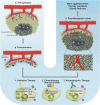Perspective of mesenchymal transformation in glioblastoma
- PMID: 33762019
- PMCID: PMC7992784
- DOI: 10.1186/s40478-021-01151-4
Perspective of mesenchymal transformation in glioblastoma
Abstract
Despite aggressive multimodal treatment, glioblastoma (GBM), a grade IV primary brain tumor, still portends a poor prognosis with a median overall survival of 12-16 months. The complexity of GBM treatment mainly lies in the inter- and intra-tumoral heterogeneity, which largely contributes to the treatment-refractory and recurrent nature of GBM. By paving the road towards the development of personalized medicine for GBM patients, the cancer genome atlas classification scheme of GBM into distinct transcriptional subtypes has been considered an invaluable approach to overcoming this heterogeneity. Among the identified transcriptional subtypes, the mesenchymal subtype has been found associated with more aggressive, invasive, angiogenic, hypoxic, necrotic, inflammatory, and multitherapy-resistant features than other transcriptional subtypes. Accordingly, mesenchymal GBM patients were found to exhibit worse prognosis than other subtypes when patients with high transcriptional heterogeneity were excluded. Furthermore, identification of the master mesenchymal regulators and their downstream signaling pathways has not only increased our understanding of the complex regulatory transcriptional networks of mesenchymal GBM, but also has generated a list of potent inhibitors for clinical trials. Importantly, the mesenchymal transition of GBM has been found to be tightly associated with treatment-induced phenotypic changes in recurrence. Together, these findings indicate that elucidating the governing and plastic transcriptomic natures of mesenchymal GBM is critical in order to develop novel and selective therapeutic strategies that can improve both patient care and clinical outcomes. Thus, the focus of our review will be on the recent advances in the understanding of the transcriptome of mesenchymal GBM and discuss microenvironmental, metabolic, and treatment-related factors as critical components through which the mesenchymal signature may be acquired. We also take into consideration the transcriptomic plasticity of GBM to discuss the future perspectives in employing selective therapeutic strategies against mesenchymal GBM.
Keywords: Glioblastoma; Master transcriptional regulator; Mesenchymal transition; TAMs; Transcriptomic plasticity.
Conflict of interest statement
The authors declare that they have no competing interests.
Figures



References
-
- Akkari L, Bowman RL, Tessier J, Klemm F, Handgraaf SM, de Groot M, Quail DF, Tillard L, Gadiot J, Huse JT, et al. Dynamic changes in glioma macrophage populations after radiotherapy reveal CSF-1R inhibition as a strategy to overcome resistance. Sci Transl Med. 2020;12:eaaw7843. doi: 10.1126/scitranslmed.aaw7843. - DOI - PubMed
-
- Aytes A, Mitrofanova A, Lefebvre C, Alvarez MJ, Castillo-Martin M, Zheng T, Eastham JA, Gopalan A, Pienta KJ, Shen MM, et al. Cross-species regulatory network analysis identifies a synergistic interaction between FOXM1 and CENPF that drives prostate cancer malignancy. Cancer Cell. 2014;25:638–651. doi: 10.1016/j.ccr.2014.03.017. - DOI - PMC - PubMed
Publication types
MeSH terms
LinkOut - more resources
Full Text Sources
Other Literature Sources
Medical

